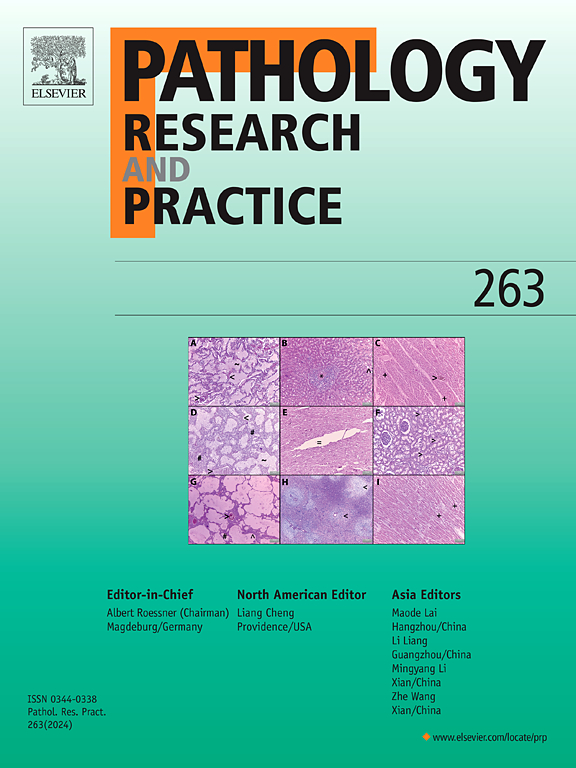Differential roles of IL-17B and IL-17RB in colorectal cancer: Correlation with immune infiltration and prognosis
IF 2.9
4区 医学
Q2 PATHOLOGY
引用次数: 0
Abstract
Background
The aim of the research is to investigate correlation of immune infiltration between IL-17B and IL-17RB in colorectal cancer (CRC), then provide an experimental basis for clinical diagnostic marker screening of CRC.
Methods
Gene expression levels were assessed via TIMER and GEPIA databases, protein expression through the Human Protein Atlas (HPA), clinicopathological correlations and prognosis via UALCAN and KM-Plotter, respectively. Mutation analysis was conducted using cBioPortal, immune cell infiltration via TIMER, and hub genes were identified through protein-protein interaction (PPI) networks. Biological functions and pathways were elucidated with Gene Ontology (GO) and Kyoto Encyclopedia of Genes and Genomes (KEGG) analysis. Finally, the expression of IL-17B, IL-17RB, and associated inflammatory cells in CRC were analyzed using immunohistochemical staining and special staining technique.
Results
Bioinformatics analysis showed that IL-17B gene and protein expression levels decreased, while IL-17RB expression increased in CRC. IL-17B expression was affected by gender, body weight, histology, lymph node status, and tumour grade. Overexpression of IL-17B was negatively correlated with progression-free survival in CRC. IL-17B is involved in phosphatidylinositol 3-kinase/AKT signaling, vascular development, and other processes. IL-17B is associated with mitochondrial gene expression, regulation of mRNA metabolism, amino acid metabolism and other processes, as well as phosphatidylinositol-binding and liganding. Inositol 3-kinase/AKT signalling and vascular development. IL-17B was negatively correlated with mitochondrial gene expression, regulation of mRNA metabolism, amino acid metabolism and other processes as well as with molecular functions such as phosphatidylinositol binding and ligase activity. IL-17RB expression was correlated with the clinicopathological features described above and decreased with tumour progression. High levels of IL-17RB were associated with improved overall survival and immune cell infiltration. The key genes of IL-17RB are mainly involved in DNA damage, metabolism, checkpoint signaling and regulation of replication. Immunohistochemical staining results showed that the expression of IL-17B and IL-17RB reduced in CRC, compared to normal colon tissue (p < 0.05). IL-17B was positively correlated with CD4+ T lymphocyte and mast cell infiltration. IL-17RB was positively correlated with CD4+ T lymphocyte infiltration and negatively correlated with CD20+ B lymphocyte infiltration.
Conclusion
The expression of IL-17RB in CRC decreased with increasing tumour stage, and high levels of IL-17RB predicted a better prognosis, suggesting that its decreased expression was associated with disease progression. Therefore, IL-17RB may be a biomarker for assessing the prognosis of CRC. Meanwhile, IL-17B was positively correlated with CD4+ T lymphocyte and mast cell infiltration, and its overexpression was negatively correlated with recurrence-free survival, IL-17B and IL-17RB may affect CRC through different pathway mechanisms.
求助全文
约1分钟内获得全文
求助全文
来源期刊
CiteScore
5.00
自引率
3.60%
发文量
405
审稿时长
24 days
期刊介绍:
Pathology, Research and Practice provides accessible coverage of the most recent developments across the entire field of pathology: Reviews focus on recent progress in pathology, while Comments look at interesting current problems and at hypotheses for future developments in pathology. Original Papers present novel findings on all aspects of general, anatomic and molecular pathology. Rapid Communications inform readers on preliminary findings that may be relevant for further studies and need to be communicated quickly. Teaching Cases look at new aspects or special diagnostic problems of diseases and at case reports relevant for the pathologist''s practice.

 求助内容:
求助内容: 应助结果提醒方式:
应助结果提醒方式:


